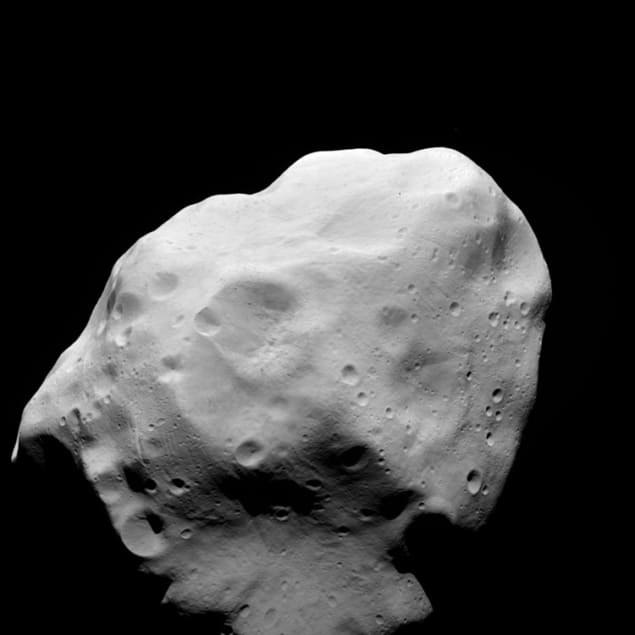
The latest results from the Rosetta space probe reveal that asteroid 21 Lutetia might have a dense metal-rich core that formed at the very start of the solar system. The fact that such a primordial core lies beneath layers of rock challenges our understanding of what the solar system was like before the planets formed.
Rosetta was launched by the European Space Agency in 2004 and its final destination is the comet 67P/Churyumov–Gerasimenko in 2014. So far on its decade-long journey, it has also encountered two asteroids – 2867 Ṧteins and 21 Lutetia – in the main asteroid belt between Mars and Jupiter. Rosetta came to within 3200 km of 21 Lutetia in July 2010 and made detailed measurements of the asteroid. Today, astronomers have published three scientific papers based on those measurements of volume, mass and spectral features – with unexpected findings.
During the fly-by, 60 images from Rosetta’s Optical, Spectroscopic and Infrared Remote Imaging System (OSIRIS) instrument were used to determine that the asteroid measures about 121 × 101 × 75 km, an overall volume only 5% different from that predicted by ground-based observations. “I was very surprised by how well the two techniques matched,” explains Holger Sierks, from the Max Planck Institute for Solar System Research, Germany, and lead-author of one of the papers.
Feeling gravity’s tug
A second paper reports on 21 Lutetia’s mass, which is inferred from the gravitational influence the asteroid had on the approaching spacecraft. The velocity of Rosetta was altered by the asteroid’s tug and this manifested itself in Doppler shifts in the radio signals it returned to Earth. After taking the gravitational influence of other solar system bodies into account, 21 Lutetia changed the frequency of Rosetta’s signals by 36.2 mHz, which translates to a mass of 1.7 × 1018 kg.
Armed with the mass and volume of the asteroid, the researchers were able to calculate its density. What they found surprised them. “It turns out that 21 Lutetia is one of the densest known asteroids,” explains Sierks. With a bulk density of 3.4 g/cm3, it is denser than most meteorite samples. Most previously observed asteroids vary in density between 1.2 and 2.7 g/cm3. This is because most are “Humpty-Dumpty” asteroids: those that have been smashed apart by collisions before slowly being put back together again by gravity. The gaps between the recombined rocks cause these asteroids to have low densities – but the Rosetta results suggest that 21 Lutetia cannot be such an asteroid.
Researchers also used Rosetta’s Visible, Infrared and Thermal Imaging Spectrometer (VIRTIS) instrument to work out the asteroid’s composition, reporting the results in the final paper of the trio. They concluded that 21 Lutetia’s regolith – the layer of dust and soil that sits atop the underlying rock – shows similar thermal properties to the powder found on the Moon. Therefore, the asteroid’s regolith is likely to have a similar density of about 1.3 g cm–3. This means that the interior of the asteroid must be even denser than the overall figure of 3.4 g cm–3. VIRTIS also failed to find signatures of metal minerals on 21 Lutetia’s surface, which provides an important clue as to the origin of the asteroid.
Primordial core is intact
Sierks believes that the Rosetta results suggest that 21 Lutetia has a primordial origin. “A metal-rich core, formed just 1–2 million years after the formation of the solar system, would account for the high density and perhaps also explain why we don’t see metals on the surface,” he said. It would have to have formed that early in order for fast-decaying radioactive isotopes to keep the fledging asteroid molten, allowing the heaviest materials [metals] to sink toward the centre. “That would make 21 Lutetia a planetesimal [a building block of planets] and it would have initially been spherical,” he added. Billions of years of collisions with other bodies would have slowly chiselled 21 Lutetia into the gnarled body that it is today, leaving its primordial core remaining intact.
However, not everyone agrees with the dense-core explanation. “The data are great, but the interpretation is flawed,” warns Denton Ebel, meteorite researcher at the American Museum of Natural History in New York. “The inference of a metal-rich bulk planetesimal composition is a stretch,” he says.
However, if true, Erik Asphaug, of University of California, Santa Cruz, thinks the finding still causes problems. “The concept of having a highly differentiated body, that is at the same time covered in rock, doesn’t fit with our previous understanding of how the solar system was formed,” he says. “It seems Lutetia violates some of the holy precepts of solar system origins.”
The trio of papers are published in Science.



